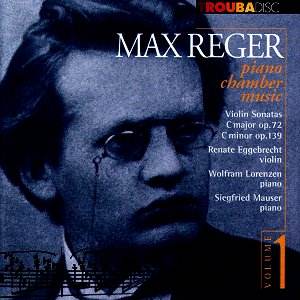Reger is, like, say, Hindemith, not the most fashionable
of composers to champion but everything of his that I have encountered,
including the music on this disc, has been at the very least interesting
and often a great deal more. The two violin sonatas represent in one
case his midpoint (exactly! he composed 146 works!) and in the other
a very late offering produced in the penultimate year of his life. That
said, by today's standards 43 might well be regarded as still being
a youthful phase! Both works are highly listenable and the exhaustive
booklet notes tend to over-analyse and intellectualise music that is
perfectly capable of speaking for itself.
The earlier C major work had its genesis in a request
to depict "the history of the sonata for violin and piano from Bach
to the present day". However, despite the notorious (at the time!) musical
motifs of sheep and monkeys, the sonata, cast in four movements, is
hardly likely to shock today except perhaps those who have been led
to believe that Reger was a dullard, musically speaking at least! In
fact, it seems quite quaint to read that the work, as did Strauss's
Sinfonia Domestica(!), established its composer's enfant terrible
status in Germany. Whatever, it is rather more forward-looking than
might be expected, and the third movement excepted, a hive of activity.
It is also, as the booklet says, a reminder that "Bach is ever present
in Reger's work", no matter what other influences come and go.
The late Op. 139 sonata is a product of Reger's final
creative spurt after his move to Jena. Despite being acknowledged as
a more classically restrained piece, it nevertheless at times invokes
Debussy at his most impressionistic. It has also been regarded as being
indicative of Reger's status as "the composer of German melancholy".
The four movement structure, with the Largo placed second this
time, ends with a wistful set of variations. It may be seen as a personal
valediction or one for a musical world radically recast by the Second
Viennese School. Formerly regarded as avant-garde himself, however
surprising that now seems, Reger, in this beautiful if resigned piece,
appeared to be accepting that times had changed. As this release ably
demonstrates, his star, and those of many like-minded contemporaries
- e.g. Schreker - who may come under the same, vague "late-Romantic"
banner, is now once again in the ascendant. The performances here are
very well played and recorded and stand up well against similar works
by Strauss and Brahms on a Chandos CD I have recently been listening
to. Far more interesting than you might imagine!
Neil Horner

![]() Renate Eggebrecht,
violin
Renate Eggebrecht,
violin ![]() TROUBADISC TRO-CD 01413
[69.14]
TROUBADISC TRO-CD 01413
[69.14]